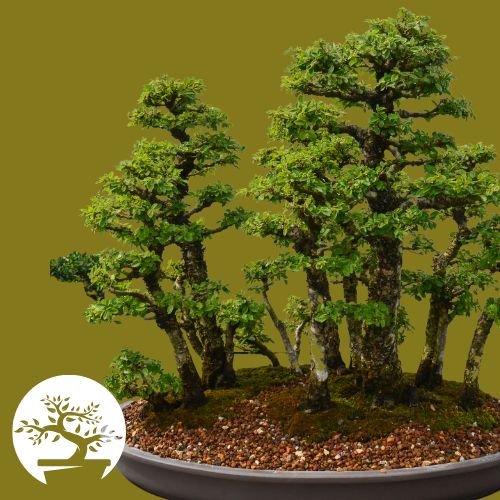Bonsai trees certainly have an air of ancient mysticism about them. Considering how long the art of bonsai has been practiced, this magical feeling isn’t surprising.
Today, we’re going to trace bonsai back to its roots and appreciate the journey these miniature trees have been on.
Where Do Bonsai Trees Come From?
Bonsai is a Japanese term that translates as “tray planting.” The art form is a decedent of the ancient Chinese practice of penjing, which is the creation of natural miniature landscapes. Bonsai slims down this idea, focusing specifically on growing miniature trees and plants.
Bonsai became a cultural phenomenon in Japan in the 19th Century, but the practice had a long history before that. So let’s take a closer look at the bonsai tree’s timeline to understand how it came to represent what it does today.
A Brief History Of Bonsai
1st Century AD – Penjing
The story of bonsai begins in China in the 1st Century. Specifically, it can be traced back to the Daoist school of thought. An element of Daoist mysticism was creating magical and spiritual locations in miniature form. It was believed that this process, known as penjing, would increase the amount of magic found in real-life sites.
Although there are stories of Daoist practitioners creating miniature landscapes at this time, concrete written descriptions didn’t appear until the 3rd or 4th Century. However, since these writings described already established techniques for shrinking down trees and plants, the practice had likely been going on for quite a while.
6th Century AD – Japan visits China
It isn’t until the 6th Century that penjing makes its way into Japanese culture. Personnel from the Japanese Imperial Embassy were fascinated by the tiny trees they saw on their trips to China. So they brought the idea back to Japan, and bonsai was born!
Medieval Period – Development of the modern bonsai
Throughout the middle ages, Japanese gardeners produced dwarfed potted trees for the wealthy aristocrats and leaders of the day. These early bonsai specimens were depicted on scrolls and in paintings. The Saigyo Monogatari Emaki scroll from 1195 is considered the earliest depiction of contained miniature trees in Japan.
17th & 18th Centuries – Growth in bonsai expertise
By the 18th Century, bonsai expertise had come a long way since the early days of cultivation. New techniques had been established and perfected, many of which we still use today. Some of the oldest known bonsai trees in the world date back to this period.
During this time, the general public became interested in the art of bonsai. As a result, exhibitions were held in the big Japanese cities displaying some of the best bonsai pots from across the country.
19th Century – The classic period
In the 19th Century, bonsai was no longer just a pursuit for the most wealthy people in society. Instead, regular Japanese people began to practice growing their miniature bonsai trees, and the art form became a very popular hobby.
The broader interest in bonsai cultivation also led to the development of better and more affordable tools. Enthusiasts could now invest in helpful equipment such as sharp root cutters and shaping wire.
By the middle of the 20th Century, around 300 professional bonsai dealers were operating in Tokyo. Japanese nurseries also became popular, where people could go and pick out young bonsai plants and grow their own small trees at home.
Today – Modern bonsai cultivation
After World War II, the Japanese bonsai community changed its practices to appeal to a broader audience. This involved taking their trees around the world for international exhibitions and building impressive displays.
The dedication of these enthusiasts certainly paid off. Today, this wonderful Japanese tradition is enjoyed all over the globe.
How Is A Bonsai Tree Created?
Creating a bonsai tree requires a lot of work, right from when the plant is just a seedling. Then, as the tree begins to emerge from the seed, it must be carefully controlled using a combination of wiring and accurate nutrition to keep it in its miniature form.
Even after a bonsai tree matures and its growth begins to slow, it still needs daily attention to stay in good health.
Do Bonsai Trees Grow In Nature?
Since the bonsai process is not natural, actual bonsai trees cannot grow freely in nature. However, there are examples of dwarf trees existing in the natural world. A dwarf tree is a bonsai tree formed without human interference.
For this to happen, the tree must have had its natural growth restricted by its environment. Often, dwarf trees are formed when tree seeds fall into cracks between rocks. The tight space and the lack of nutrients stop the tree from growing as it usually would.
Can You Make Bonsai Out Of Any Tree?
In theory, almost any tree or shrub can be made into a bonsai plant. Of course, some trees are more challenging to work with than others, but once you’ve mastered wiring and pruning techniques, you shouldn’t have too much trouble.
What’s The Most Important Technique To Master As A Bonsai Enthusiast?
Over the years, there has been constant development in bonsai cultivation techniques. Grafting, clamping, defoliation, and deadwood processes have been invented and refined to help growers get the most out of their trees.
That said, the most crucial technique of all has to be the humble prune. Pruning your bonsai is essential for many reasons. Not only does it improve the aesthetics of the tree, but it also prevents it from growing too fast and getting out of control. A bonsai that is growing too fast can quickly become unhealthy.
